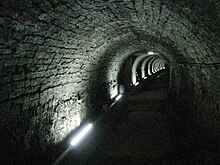Victoria Tunnel (Newcastle)

A lit section of the Victoria Tunnel near the Ouse Street entrance
|
|
| Overview | |
|---|---|
| Location | Newcastle upon Tyne, England |
| Start | Town Moor |
| End | River Tyne |
| Operation | |
| Work begun | 1839 |
| Opened | 7 April 1842 |
| Technical | |
| Length | 2.4 miles (3.9 km) |
The Victoria Tunnel is a subterranean wagonway that runs under Newcastle upon Tyne, England, from the Town Moor down to the River Tyne. It was built between 1839-42 to transport coal from Leazes Main Colliery in Spital Tongues to riverside staithes (jetties) ready for loading onto boats for export.
The tunnel was driven through boulder clay and formed by a base course of stone supporting a brick arch. Loaded wagons descended the incline of the tunnel under their own weight, and were rope-hauled back to the colliery by a stationary engine. The Colliery closed in January 1860 and the Tunnel was abandoned until the start of the Second World War when it was converted for use as an air raid shelter.
The tunnel is 2.4 miles (3.9 km) in length with a maximum depth of 85 feet (26 m) and drops 222 feet (68 m) from entrance to exit. It remains largely intact.
When it opened in 1835, the Leazes Main or Spital Tongues colliery was one of many coal mines around Newcastle. The Industrial Revolution was in full swing: demand for coal was high and the competition was great.
Initially, the coal was carried on carts from the colliery through the streets of Newcastle upon Tyne to the river, ready for shipping. This was slow, as the town was largely still in its medieval layout, with narrow cobbled streets (Grainger Town was still in the early stages of construction) and expensive because of the road taxes. Porter and Latimer, the colliery owners, therefore employed a local engineer, William E. Gilhespie, to construct an underground wagonway. An overground waggonway following much the same route was mooted, but the Freemen of Newcastle would not give permission for tracks to be laid across the Town Moor. A more direct route to Elswick, about two miles upstream from the mouth of the Ouseburn, was also ruled out, because the old Tyne Bridge (the Swing Bridge would not be built until 1873) prevented ships sailing beyond Newcastle. Building a staithe here would involve having to pay the keelmen to take the coal downstream of the bridge before it could be loaded into the colliers, thereby significantly reducing the profit margin on each load of coal shipped.
...
Wikipedia
